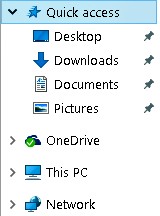Windows 10 lets you quickly shortcut your way to nearly anything you need. Look at most “real” desktops, and you’ll see the most-used items sitting within arm’s reach: the coffee cup, the stapler, and perhaps a few crumbs from the coffee room snacks. Similarly, Windows 10 gathers your PC’s most frequently used items and places them in the Navigation Pane. The Navigation Pane offers shortcuts to places you visit most frequently.
The Navigation Pane offers shortcuts to places you visit most frequently.
 The Navigation Pane offers shortcuts to places you visit most frequently.
The Navigation Pane offers shortcuts to places you visit most frequently.Found along the left edge of every folder, the Navigation Pane contains several main sections: Quick Access, OneDrive, and This PC. (On PCs connected through a network, you’ll see an entry for Network, as well.) Click any of those sections — Quick Access, for example — and the window’s right side quickly shows you the contents of what you’ve clicked.
Here’s a more detailed description of each part of the Navigation Pane:- Quick Access: Formerly called Favorites, these locations serve as clickable shortcuts to your most frequently accessed locations in Windows.
- Desktop: Your Windows desktop, believe it or not, is actually a folder that’s always spread open across your screen. Clicking Desktop quickly shows you the contents of your desktop.
- Downloads: Click this shortcut to find the files you’ve downloaded while browsing the Internet. Ah, that’s where they ended up!
- Documents: A perennial favorite, this folder stores most of your work: spreadsheets, reports, letters, and other things you’ve created.
- Pictures: Another popular destination, this takes you to photos you’ve shot yourself or saved from the Internet.
- OneDrive: This free online storage space was handed to you by Microsoft when you created a Microsoft account. (Without a Microsoft account, it’s simply another folder on your PC.) Because OneDrive is password-protected and online, it’s tempting to fill it with favorite files for access from any PC, phone, or other Internet-connected device. But when your stored files exceed your storage limit, Microsoft asks for your credit card to pay for the extra space.
- This PC: This section lets you browse through your PC’s folders and hard drives. (Many of these commonly used storage areas live in the Navigation Pane’s Quick Access area, as well.) The This PC section holds these areas:
- 3D Objects: Embraced mostly by procrastinators and game designers, this new folder contains pictures that become movable 3D objects when opened in the new Paint 3D program. Chances are, you’ll never set foot in this virtual weirdness.
- Desktop: Click this to see the files and folders stored on your desktop. (Or, you can just close the folder and see your desktop in person.)
- Documents: This opens the Documents folder, a convenient repository for letters, forms, and reports.
- Downloads: Downloaded a file from a website? Then look in here to be reintroduced.
- Music: Yep, this shortcut jumps straight to your Music folder, where a double-click on a song starts it playing through your PC’s speakers.
- Pictures: This shortcut opens your Pictures folder, the living quarters for all your digital photos.
- Videos: Click here to visit your Videos folder, where a double-click on a video opens it for immediate viewing.
- Local Disk (C:): A holdover for old techies, this entry lets you crawl through any folder on your PC. Unless you know specifically what item you’re seeking, though, you probably won’t find it. Stick with the other destinations, instead.
- Disc Drives: If your PC includes extra disc drives, icons for those appear here. Insert a flash drive into your USB port, and its icon appears here, as well.
- Network: Once you create a network from the PCs in your home, their names appear here.
- To avoid treks back to the Start menu, add your own favorite places to the Navigation Pane’s Quick Access area: Right-click a favorite folder and choose Pin to Quick Access from the pop-up menu. (Similarly, right-click any unwanted listing in the Quick Access area and remove it by choosing Unpin from Quick Access.)
- If you’ve connected to a network at home or work, the pane’s This PC section may include those other computers’ music, video, and photos (which are sometimes referred to as media). Click those computers’ icons to access those goodies as if they were stored on your own computer.
- Windows 7 owners may notice that Windows 10 doesn’t show libraries in the Navigation Pane. Libraries still exist, but they’re hidden in the background. To bring them back into view, click a blank portion of the Navigation Pane and choose Show Libraries from the pop-up menu. (You must also manually add the Public folders to each library in order to return them to the glory days of Windows 7.)





